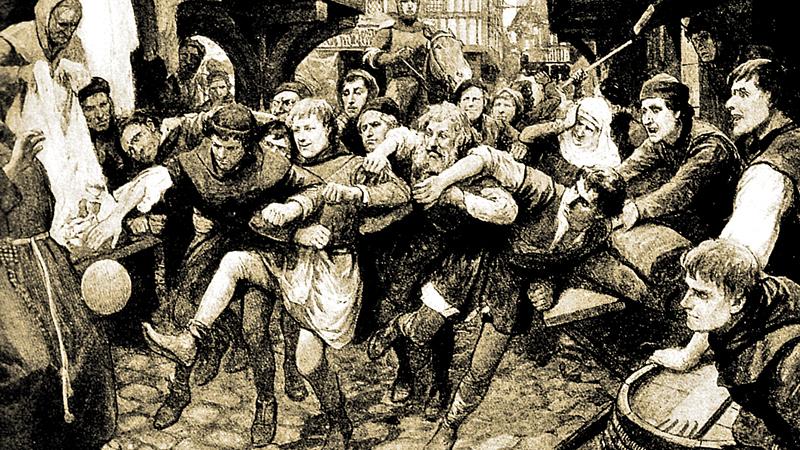
Football, or as it is sometimes known, soccer, is a team sport that pits two teams of 11 players against each other, scoring points by kicking a spherical ball through the opponent’s goal.
By a wide margin, football is easily the most popular sport in the world, with over 250 million players across 200 countries. However, what most people recognize as simply Football, is officially called Association Football and is simply just one of many ball sports that fall under the larger category of Football.
The term Football, more generically, refers to the greater family of sports that involve, to varying degrees, kicking a ball through into a goal. Besides Association Football (Soccer), the category of Football also includes many more popular sports, like American Football, and Rugby. And while the currently popular variations of Football, called Football codes, are relatively new, the history of ball sports that involve kicking a ball into a goal dates back centuries.
Cuju
 The oldest recorded game resembling football, unsurprisingly, comes from ancient China around the 2nd and 3rd Centuries BC Called Cuju, the sport greatly resembled what is now Association Football, and is officially recognized by FIFA as the origin of the sport. Cuju was played in an enclosed field for play, and players could interact with the ball with any part of their body outside of their hands.
The oldest recorded game resembling football, unsurprisingly, comes from ancient China around the 2nd and 3rd Centuries BC Called Cuju, the sport greatly resembled what is now Association Football, and is officially recognized by FIFA as the origin of the sport. Cuju was played in an enclosed field for play, and players could interact with the ball with any part of their body outside of their hands.
Goals were scored by kicking the ball through a narrow hole in a net held up high by two posts in the middle of the field.
Ancient Chinese records note the sport being used for fitness training in the military, though it also spread to nobles and the wealthy class as entertainment.
Historically, the cuju sport was further split into separate styles, zhuqiu and baida, each with distinct rules. Zhuqiu is similar to modern football, having two teams of 12-16 players attempting to score goals.
Baida is more about personal achievement, forgoing teams to instead assign points to players, with the best individual score winning the game. Cuju would directly inspire the Japanese game of Kemari, a single player game similar to hacky sack that is still played to this day.
In Ancient Greece, a sport quite similar to modern Rugby, called Episkyros, was recorded in between 400 and 300 B.C.
Each team had about 12-14 players trying to get a ball across a white line drawn at either end of the playing field. Players were allowed the use of hands to handle the ball and games were often violent, especially in Sparta.
Though the game’s rules resemble that of Rugby, there is no direct link tying the two sports together, so it can only be assumed that Rugby is completely independent of Episkyros.
 This and one other similar Greek sport called phaininda are believed to have been Romanized into the Ancient Roman ball sport of Harpastum, though there aren’t enough records of rules for that sport to confirm this, but what impressions that could be derived note it to be much more violent than its Greek counterparts.
This and one other similar Greek sport called phaininda are believed to have been Romanized into the Ancient Roman ball sport of Harpastum, though there aren’t enough records of rules for that sport to confirm this, but what impressions that could be derived note it to be much more violent than its Greek counterparts.
Variations
Many other variations of Football type games would be played spontaneously, completely independent from each other. Such as the Native American game of Pasuckuakohowog, which exclusively played by kicking a ball, though each game would have hundreds of players at a time, was often dangerous and described to be like a war.
Indigenous Australian people also had many games and sports revolving around kicking balls, all generalized under the name Marn Grook, or “ball game”.
Observers could not grasp the exact rules of these games, but they involved punting and catching, and are considered precursors to Australian Football.
However, the direct inspiration for modern Association Football would come about in Medieval Europe, with a type of Football called Mob Football played all across Europe over the course of centuries.
Unlike most other examples mentioned from other cultures, Mob Football had very few rules and anything was allowed to get the ball into the opponent’s goal as long as it didn’t involve killing someone. Though there were many attempts to outlaw this form of Football in Europe, it would persist until it eventually evolved into modern Association Football.
